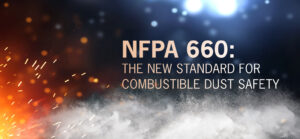A company using pneumatic conveyors to move grass seeds into storage bins manually cleaned dust and dirt with shovels and brooms. Its old dust collector, equipped with horizontal filter cartridges, was ineffective due to insufficient airflow. Unaware of the hazards posed by combustible dust or the relevant National Fire Protection Association (NFPA) standards for prevention, the facility operator faced significant risks.
Seeking a solution for better dust control, the company reached out to Camfil APC. Brian Richardson, Camfil APC regional manager, responded promptly, scheduling an on-site visit the same day. After thoroughly inspecting its processes, Brian and his team identified the necessary upgrades and determined which parts of the existing system could still be used. The company hoped to salvage as much of its current dust collector as possible to reduce costs.
The Camfil APC team went beyond recommending improvements and thoroughly educated the company’s personnel on the dangers of combustible dust and the applicable NFPA standards. This visit revealed the existing dust collection system not only fell short of compliance but also posed an elevated risk of explosion.
Following a visit to one of Camfil's customer sites where a newly installed system was in operation, company leaders recognized the value of switching to Camfil. They were impressed by the enhanced performance of the dust collector and the assurance of NFPA compliance.
Watch the Full Switching Story
To get the full story, watch Camfil APC’s Brian Richardson in this video.
Risks Associated with Combustible Dust
Many companies produce airborne dust during their operations, which can affect indoor air quality as it floats in the air or settles on surfaces. While some dust poses less severe problems, like allergic reactions and slipping hazards, others can be highly dangerous, presenting both more serious health issues and combustion risks. Note all airborne particles can impact worker comfort and productivity and must be properly managed.
Dust generated when handling, storing and processing seeds has a higher combustion potential because of its high organic carbon content and fine particle size, which can make it more prone to ignite. A dust explosion can occur when a concentrated cloud of combustible dust comes into contact with an ignition source in a confined space.
Additionally, dust from agricultural products like seeds can be harmful to workers’ health. In addition to allergic reactions, it can cause, asthma, or even long-term conditions such as lung cancer. Beyond its impact on health, this dust can also harm the environment. Since many operations keep factory doors open during certain times of the year, the dust can exit the building and spread over large areas when carried by the wind.
Importance of Dust Collectors
Industrial dust collector systems are the most efficient way to reduce large quantities of dust and prevent its spread throughout a plant. Because they use filter cartridges that continually self-clean, they can remove airborne particles for long periods of time before requiring a change of filters.
However, dust collectors must be designed according to the manufacturing process used at the facility and type of dust being collected. If the dust is combustible, the dust collector must be equipped with additional safety equipment to mitigate combustible dust explosions.
If the dust is toxic, a dust collector with high-efficiency primary and secondary cartridge-style filters can be used to safely contain the dangerous dust. Powered with the appropriate filters, cartridge dust collectors can remove very fine particulates with up to 99.97% efficiency at 0.3 microns.
Camfil’s Gold Series industrial dust collectors are designed to remove toxic and combustible dusts from an environment. They are the industry’s best-in-class dust collection system that exceeds NFPA and ATEX standards for explosion protection.
NFPA Compliance
NFPA 652 Standard on The Fundamentals of Combustible Dust provides recommended practices for managing combustible dust fire and explosion hazards. Many insurance agencies and local fire codes require compliance with NFPA standards.
NFPA 660 will soon replace standard 652, combining all existing dust standards under one unified code. The new standard will simplify assessments and compliance with test standards by combining all relevant information at one source. It will also streamline the identification of standards applying to combustible dust explosions.
With its knowledge of NPFA standards, Camfil Air Pollution Control can guide you in mitigating combustible dust at your facility by specifying a compliant and effective dust collection system. Contact our dust collection experts to assess your needs and recommend the most effective dust collection system for your requirements.
 Americas
Americas 




